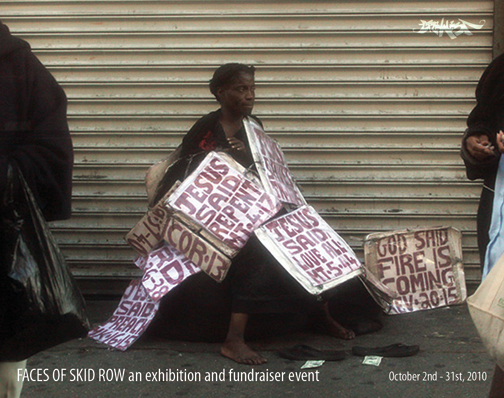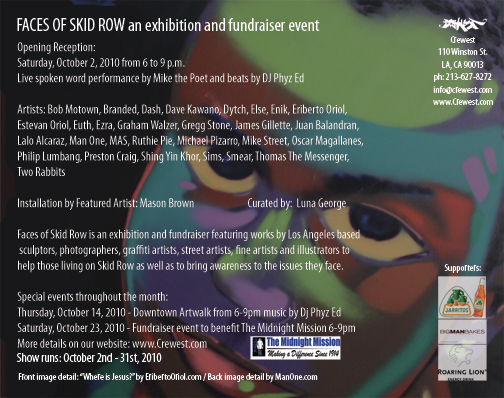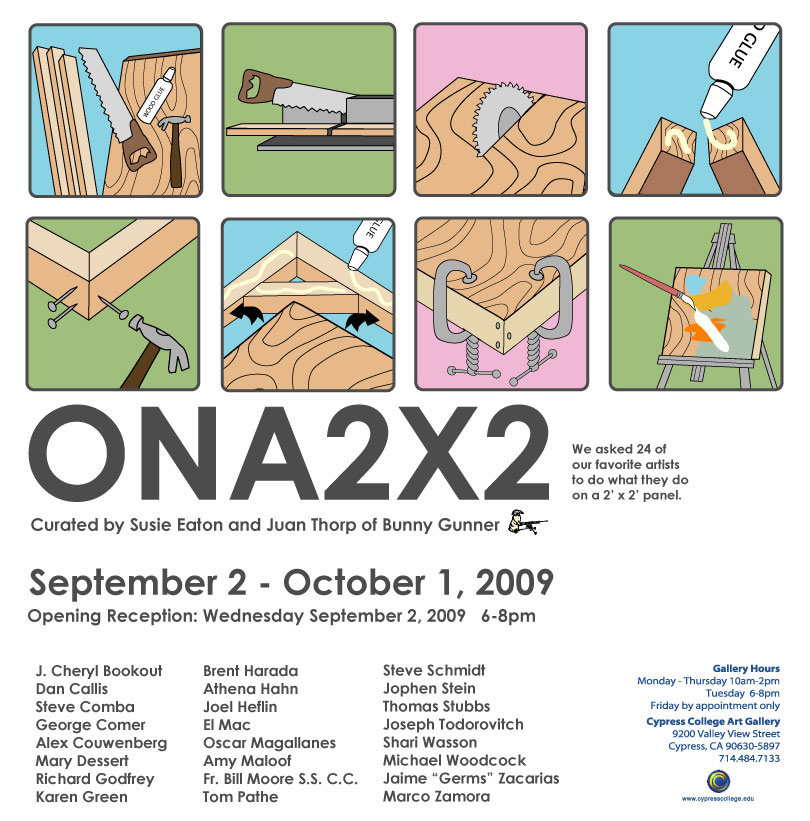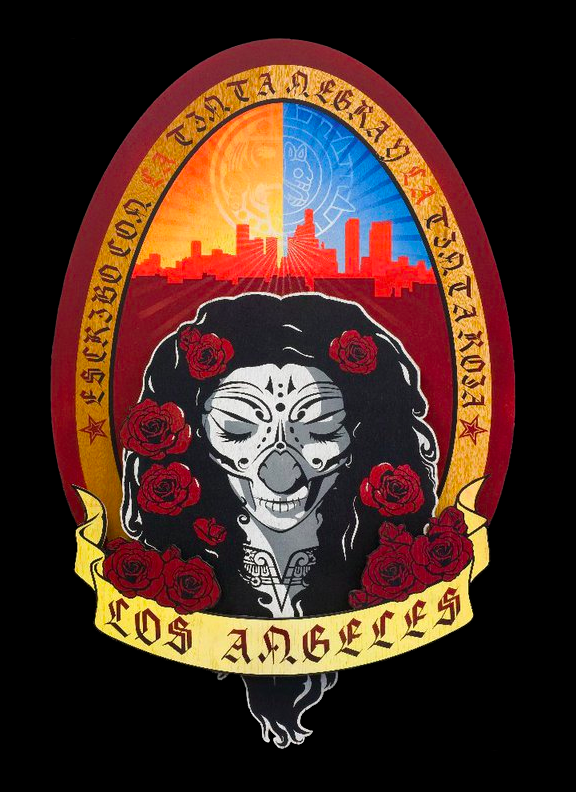I will be participating in this upcoming show at Crewest.


I will be participating in this upcoming show at Crewest.


Some pictures of my painting for Smoking Mirrors Gallery’s Dia de los Muertos show. Did this in honor of all the woman who have been murdered in the city of Juarez, Mexico.
I will be installing my Alta Altar in this show. Here is the info:
The Art Exhibition Sacred Memories: Contemporary and Cross Cultural Expression of Day of the Dead will be on display at the Pico House Gallery October 30 through November 28th, 2010 from 10:00 a.m. – 3:00p.m. (Wednesday through Sunday only.) The exhibit features work from local Los Angeles and national artists using a variety of medium including paint and sculpture. The exhibit also includes altar and shrine installations and explores Dia de los Muertos/Day of the Dead and other rituals venerating departed loved ones.
As part of the opening reception there will be a performance excerpt of “Calavereando” written and directed by Paulina Sahagun. Experience the humorous dancing and singing of the politically satirical Calacas dancers. It is an evening of culture and art not to be missed!
The Pico House Gallery
424 North Main Street
Los Angeles, CA 90012
(213) 485-8437

Found these clips from my trip to Chiapas in 2005/2006. It is footage of the Zapatista and Marcos at the kickoff of La Otra Campaña.
Original text by Luna George’s posting for Juxtapoz Magazine’s Blog.
With seven candles representing his immediate family and a poem by Nezahualcoyotl surrounding the three tiered altar, Oscar Magallanes’ beautiful Altar Installation “Hasta Llegara a Mictlán” at Crewest Gallery during their Top of the Dome exhibition has captured my eye. Heavily influenced by the cultural and social elements of his upbringing such as murals of Zapata and Mexica glyphs from the Chicano movement, Oscar provides in his own words an explanation to the creation of his altar “Hasta llegara a Mictlán”:
“The cross created by the ancient Mesoamerican glyphs for fire and water is actually an axis mundi representing the four cardinal points. In Mesoamerica there was also an understanding of the importance of including a center point represented here by the symbol of Ometeotl. All of the indigenous cultures of what is now the Americas would situate their cities to these points. The axis mundi was used to represent life whether external or internal, physical and spiritual thus becoming a representation of the Universe. To the Mexica there were nine levels in the underworld the furthest being Mictlan. It is in Mictlan that Quetzalcoatl descended to to recover the bones of ancestors and reestablish human kind in the fifth sun. The lower portion of the axis mundi represents its reach into these levels with the skull at the bottom to represent our ancestors.
To tie the piece into current issues I wrapped the two symbols of Quetzalcoatl forming a sort of caduceus often used to represent medicine and physicians. I wanted to create a symbol that represented indigenous philosophies and was almost a mirror of western iconic symbols that was in every sense a mirror image. That is to say the opposite of what it’s counter parts are. In this era of “healthcare reform” I think it is important to present alternatives to corporate healthcare and rediscover what has been taken from us, the fact that we can heal ourselves and have done so since the beginning of time. At the point of the first encounter with Europeans the vast cultures of Mesoamerica had already documented over three thousand plants for medicinal uses.
The photo is of my grandfather who is on the left. We were told he passed away from cancer but after an independent autopsy was performed it turned out that he had passed away from complications of a bad blood transfusion. The four vases holding calla lilies represent my grandparents. My maternal grandparents who lived in the United States passed away at a relatively early age while my paternal grandparents in Mexico both passed away in there 90’s.”
Here is the poem by Nezahualcoyotl which surrounds the three tiered altar:
I am intoxicated,
I weep, I grieve
I think, I speak
Within myself I discover this
Indeed I shall never die
I shall never disappear
There is no death
There where death is overcome
Let me go there
Indeed I shall never disappear.
Please note this beautiful altar is on view till the end of November at Crewest Gallery in Downtown Los Angeles.

I was approached by John Daly of John Daly Inc. to do a backdrop for Land Rover as they debuted their 2010 Range Rover Sport at the Downtown Standard in conjunction with the ESPYS Awards. They wanted something urban so I called up my good friend Retna so we could do our thing. Here are a few pics.
The piece has the saying “Escribo Con La Tinta Negra Y La TInta Roja,” I write with the black and red ink. It is a reference to pre-columbian, mesoamerican beliefs in the importance of the Toltecatls, the artist who drew the codex.

Here are a few pics and a statement for the altar I did for Tropico de Nopal.
My altar is in honor of my ancestors and the struggles they have persevered. It also makes a statement on contemporary issues. In January 2006 I traveled to Chiapas Mexico as part of a People of Color’s Delegation to the Zapatistas autonomous zones. I witnessed first hand the disastrous effects of globalization, NAFTA (North Atlantic Free Trade Agreement), and the growing influence of multinational corporations on the world’s environment.
One of the effects of NAFTA was the displacement of thousands of Mayans from their indigenous lands causing many to migrate north to the United States seeking jobs. I also was witness to the over 30 thousand Zapatistas that marched into San Cristobal de las Casas as part of the beginning rally for La otra campaña. I find beauty in that struggle in opposition to oppression and seek to represent it in my work.
The nopal that is the centerpiece is modeled after one growing in my backyard. I rescued the nopal from the South Central Farm on June 13th 2006, the same day over 300 Sheriffs and LAPD officers raided the farm and evicted the farmers along with protestors and activist. Just as no one could have imagined the nopal would have ended up in Pomona I used it to draw parallels to the migration patterns of Mexican’s though out our history in this land.
The nopal it self serves as an important symbol. Replacing the traditional family tree with a nopal seemed much more appropriate. I set the nopal in the context of the Los Angeles city skyline to juxtapose the natural garden being transplanted into the concrete city by the farm workers. Like the nopal I find we share similar characteristics. We are tough, resilient, and when forced to, we flourish elsewhere even in the harshest of conditions.